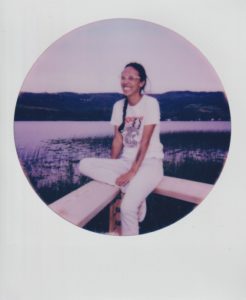Whess Harman’s chew the bones, they’re soft exhibit is in Harman’s own “potlatch punk” style, which incorporates their own work with collaborations with other local Indigenous artists. Harman says the inspiration for their artwork comes partly from their complex interaction with the concepts of home and identity.
“A lot of [my ideas] are about home and yearning, and I wouldn’t say that I’m estranged from my community, but it’s a bit of a difficult place to navigate as someone who’s queer and the town I come from is pretty small and pretty conservative, and I know I’d have a hard time living there,” says Harman. “Most of my work has been about this push and pull of wanting to go home, but knowing it’s not necessarily going to be the thing I want.”
A major theme of the show is that of exploring the potlatch from a historical and contemporary perspective.

“It’s our government; it’s how people gather and make the collective community decisions, but it was also important as a social event,” says Harman. “And sometimes someone has a better year than someone else, so it’s a way of redistributing resources and making sure everyone has something, rather than hoarding it, essentially.”
Harman says that the nation-wide ban on potlatches, which spanned from 1885 to 1951, had a profound impact on Indigenous culture because it outlawed a practice that embodied and pervaded every aspect of how the native Canadian peoples ran their societies.
“Potlatches are so interesting, because they’re governance, they’re culture, they’re art, they’re social; like it really is the nexus of everything about who we are, so to take that away was such a huge blow to so many communities,” says Harman. “That was 66 years where we didn’t get to explore our own culture freely, we didn’t get to innovate, we didn’t get to be flexible and move with the time in the same way, and I think we are starting to move back to that.”
An Emily Carr University graduate, Harman says that they don’t agree with the idea that art has to prescribe to a strict style.
“I think the frustrating thing I had coming out of a post-secondary program was this idea that contemporary art had to be perfect and polished, and look very manufactured in a particular way, and I think that’s really intimidating,” they say. “It’s like, if you have an idea, it doesn’t have to work out, what’s actually more important is to just try it and see if you like it. A lot of my projects, they’re a little messy, and you can see the mistakes, and I’m happy to share those mistakes as a way of signalling that you can do this, and there is value in it, and there’s value in the mistakes, and relearning and reapproaching the work.”
Regarding the title of the exhibit, Harman recalls a childhood memory that stuck with them.
“The first time I was conscious of eating fish, I just remember asking my mom, ‘Can I eat the bones?’ which is just such a morbid sounding thing, but she just laughed and said, ‘Yeah, of course you can eat them,’ just very warm and tender about it,” says Harman. “What I would really like is to just offer that invitation to someone, to be like, yes, absolutely, chew on the thing that is tough.”
chew the bones, they’re soft
Until Saturday, April 30
Open Space
openspacearts.ca
